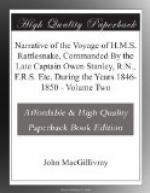1. ON THE BATHYMETRICAL DISTRIBUTION OF MARINE TESTACEA ON THE EASTERN COAST OF AUSTRALIA.
As in every instance the exact locality, depth and character of habitat of species of Mollusc taken were carefully noted of at the time of capture, much more valuable information elucidating the distribution of shellfish in the Australian seas has been collected during this expedition than was ever before obtained. Whilst new species are usually sought after by collectors with eagerness, the habits and range of the commoner or less conspicuous forms are passed over without observation.* Hence every note on the habitat and mode of life of marine creatures from the southern hemisphere becomes of no small value. Indeed, there is no information more desirable at this time for the illustration of geological phenomena, than such as may throw light on the distribution in range and depth of the creatures inhabiting the sea of the Tropics, and those living around the coasts of Australia and New Zealand. The following notes will serve to record the more prominent facts bearing upon the Bathymetrical distribution of the Testacea collected on the northern coast of Australia, at Port Essington, and on the eastern coast from Cape York to Bass Strait, including the northern ports of Van Diemen’s Land.
(Footnote. An extensive collection of landshells was made at Madeira. They proved on examination to be all known species, including several of the rarer forms, and not a few of those discovered by the Reverend Mr. Lowe. They were compared with Madeiran specimens by Mr. Vernon Wollaston. When the Rattlesnake touched at the Azores on the return voyage, a few landshells were collected at Fayal. Among them was the Helix barbula, an Asturian species, Helix pauperata, and Bulimus variatus, Madeiran or Canarian forms. A considerable number of marine and terrestrial Testacea were procured at Rio de Janeiro, not a few of them new and of great interest. Terebratula rosea was dredged off Rio in thirteen fathoms water, on a coarse sandy bottom. Collections were also made at the Cape of Good Hope, at Mauritius and in the Falkland Isles. The radiata were gathered with as much care and their habitats recorded with as much attention as the Mollusca.)
It may here be remarked that the Molluscan fauna of the seas of North Australia and of the north-east coast from Cape York southwards to Sandy Cape, belongs to the great Indo-Pacific province, a zoological region extending from the east coast of Africa (from Port Natal or a little above, northwards to Suez) to Easter Island in the Pacific. But south of Sandy Cape and onwards to Van Diemen’s Land (and apparently including New Zealand) we have a distinct (East)Australian province, marked by a peculiar fauna in many respects, representative of the Senegal, and perhaps also Lusitanian regions of the North Atlantic.
Proceeding in descending order we may first remark on the:




